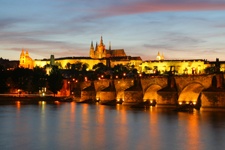






Prague airport transfer, Prague taxi & transfers
- cheaper than taxi
- free map
- money-back guarantee
- VIP service
- safety, comfortable and
air-condition vehicles - 24/7 support
- fixed price




Prague airport taxi & transfers
We accept all major Credit Cards:

Prague Airport
PRAGUE AIRPORT RUZYNE

Ruzyně Airport (IATA: PRG, ICAO: LKPR) serves Prague, Czech Republic. Located 20 km from the city centre, the airport is a hub for Czech Airlines. It was opened on April 5, 1937. Prague-Ruzyně airport is the biggest airport in the Czech Republic and with 12.7 million passengers in 2008 the busiest one within the new EU member states. It was named the best airport in Central and Eastern Europe by Skytrax in 2005 and 2007. The airport contains two runways in service: 06/24 and 13/31.
Public transport to and from Prague city center involves taking the bus number 119 to Dejvická metro station and transferring on to the green metro line (Line A) or Tram there or express number 100 to Zličín metro station (yellow Line B) farther from the city centre. A typical trip takes about 45-60 minutes. After midnight when the metro line is closed, night bus number 510 runs from the airport, but it takes longer.
The best way is use Prague airport transfer, which is more comfortable and much faster.
This Prague transfer is also cheaper than Prague taxi. BOOK NOW
ABOUT PRAGUE

Prague is the capital and largest city of the Czech Republic. Its official name is Hlavní město Praha, meaning Prague, the Capital City.Situated on the River Vltava in central Bohemia,
Prague has been the political, cultural, and economic centre of the Czech state for more than 1100 years. The city proper is home to more than 1.2 million people, while its metropolitan area is estimated to have a population of over 1.9 million.
Since 1992, the extensive historic centre of Prague has been included in the UNESCO list of World Heritage Sites. According to Guinness World Records, Prague Castle is the largest ancient castle in the world.
Nicknames for Prague have included "the mother of cities" (Praga mater urbium, or "Praha matka měst" in Czech)", "city of a hundred spires" and "the golden city".
WHAT TO SEE
Prague Castle is the most popular sight visited in Prague. It is the largest ancient castle in the world (570 m long, on average 128 m wide, area 7.28 hectares).
Constructed in the 9th century by Prince Bořivoj, the castle transformed itself from a wooden fortress surrounded by earthen bulwarks to the imposing form it has today. Rulers made their own additions so there is a mixture of styles. Prague castle has had four major reconstructions, but it keeps its classical facelift it took on in the 18 century during the reign of Maria Theresa.
The castle has three courtyards and it has always been the seat of Czech rulers as well as the official residence. Allow at least half a day (it does not include time for museum visits) if you want to examine it in depth.
The Lesser Town was founded in 1257 on the slopes bellow the Prague castle and it is the part of Prague least affected by resent history.
Jewish Quarter (Josefov) named after the emperor Josef II, whose reforms helped to ease living conditions for the Jewish, the Jewish Quarter contains the remains of Prague's former Jewish ghetto. As many of the Jewish died during the WWII and were forced by the communist regime to leave the country, the current Prague community numbers 5000 – 6000 people. There are two figures synonymous with this part of the city,
Franz Kafka (1883 – 1924) and the mystical humunculus Golem created by Jehuda ben Bezalel, also known as Rabi Löw.
Prague Old Town mentioned in 1091, it is the oldest of the towns of Prague gained the privileges of a town in the 13th century. However, its name dates back to the 14th century when the New Town was founded. The centre of the Old Town has always been the Old Town Square dominated by the Church of Our Lady of Týn and the Town Hall.
Prague New Town - the carefully planned New Town was founded by Charles IV in 1348. Twice as large as the Old Town, it was mainly inhabited by tradesmen and craftsmen.
During the late19th century its outer fortification were demolished and redeveloped to its present appearance. Today it is not particularly attractive to tourists because of its modernness.